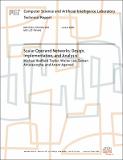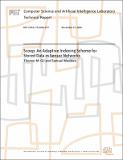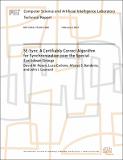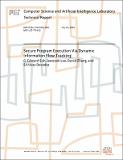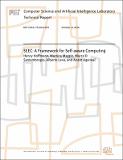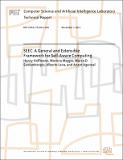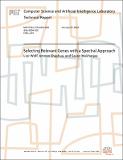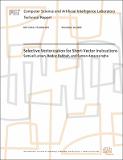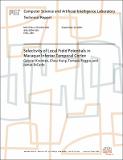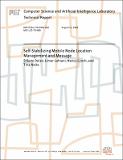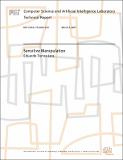Browsing CSAIL Digital Archive by Title
Now showing items 636-655 of 806
-
Scalar Operand Networks: Design, Implementation, and Analysis
(2004-06-08)The bypass paths and multiported register files in microprocessors serve as an implicit interconnect tocommunicate operand values among pipeline stages and multiple ALUs. Previous superscalar designs implementedthis ... -
Scale Control Processor Test-Chip
(2007-01-12)We are investigating vector-thread architectures which provide competitive performance and efficiency across a broad class of application domains. Vector-thread architectures unify data-level, thread-level, and instruction-level ... -
Scene Classification with a Biologically Inspired Method
(2009-05-10)We present a biologically motivated method for scene image classification. The core of the method is to use shape based image property that is provided by a hierarchical feedforward model of the visual cortex [18]. Edge ... -
Schematic Querying of Large Tracking Databases
(2006-06-12)In dealing with long-term tracking databases withwide-area coverage, an important problem is in formulating anintuitive and fast query system for analysis. In such a querysystem, a user who is not a computer vision research ... -
Scoop: An Adaptive Indexing Scheme for Stored Data in Sensor Networks
(2006-11-27)In this paper, we present the design of Scoop, a system for indexing and querying stored data in sensor networks. Scoop works by collecting statistics about the rate of queries and distribution of sensor readings over a ... -
SE-Sync: A Certifiably Correct Algorithm for Synchronization over the Special Euclidean Group
(2017-02-05)Many important geometric estimation problems naturally take the form of synchronization over the special Euclidean group: estimate the values of a set of unknown poses given noisy measurements of a subset of their pairwise ... -
Secondary Structure Prediction of All-Helical Proteins Using Hidden Markov Support Vector Machines
(2005-10-06)Our goal is to develop a state-of-the-art predictor with an intuitive and biophysically-motivated energy model through the use of Hidden Markov Support Vector Machines (HM-SVMs), a recent innovation in the field of machine ... -
Secure Program Execution Via Dynamic Information Flow Tracking
(2003-07-21)We present a simple architectural mechanism called dynamicinformation flow tracking that can significantly improve thesecurity of computing systems with negligible performanceoverhead. Dynamic information flow tracking ... -
Securing Deployed RFIDs by Randomizing the Modulation and the Channel
(2013-01-12)RFID cards are widely used today in sensitive applications such as access control, payment systems, and asset tracking. Past work shows that an eavesdropper snooping on the communication between a card and its legitimate ... -
SEEC: A Framework for Self-aware Computing
(2010-10-13)As the complexity of computing systems increases, application programmers must be experts in their application domain and have the systems knowledge required to address the problems that arise from parallelism, power, ... -
SEEC: A Framework for Self-aware Management of Multicore Resources
(2011-03-24)This paper presents SEEC, a self-aware programming model, designed to reduce programming effort in modern multicore systems. In the SEEC model, application programmers specify application goals and progress, while systems ... -
SEEC: A General and Extensible Framework for Self-Aware Computing
(2011-11-07)Modern systems require applications to balance competing goals, e.g. achieving high performance and low power. Achieving this balance places an unrealistic burden on application programmers who must understand the power ... -
Selecting Refining and Evaluating Properties for Program Analysis
(2003-07-21)This research proposes and evaluates techniques for selectingpredicates for conditional program properties—thatis, implications such as p ) q whose consequent must betrue whenever the predicate is true. Conditional ... -
Selecting Relevant Genes with a Spectral Approach
(2004-01-27)Array technologies have made it possible to record simultaneouslythe expression pattern of thousands of genes. A fundamental problemin the analysis of gene expression data is the identification ofhighly relevant genes that ... -
Selective Vectorization for Short-Vector Instructions
(2009-12-18)Multimedia extensions are nearly ubiquitous in today's general-purpose processors. These extensions consist primarily of a set of short-vector instructions that apply the same opcode to a vector of operands. Vector ... -
Selectivity of Local Field Potentials in Macaque Inferior Temporal Cortex
(2004-09-21)While single neurons in inferior temporal (IT) cortex show differential responses to distinct complex stimuli, little is known about the responses of populations of neurons in IT. We recorded single electrode data, including ... -
Self-Adaptive Systems for Information Survivability: PMOP and AWDRAT
(2007-04-10)Information systems form the backbones of the critical infrastructures of modern societies. Unfortunately, these systems are highly vulnerable to attacks that can result in enormous damage. Furthermore, traditional approaches ... -
Self-Stabilizing Message Routing in Mobile ad hoc Networks
(2009-01-28)We present a self-stabilizing algorithm for routing messages between arbitrary pairs of nodes in a mobile ad hoc network. Our algorithm assumes the availability of a reliable GPS service, which supplies mobile nodes with ... -
Self-Stabilizing Mobile Node Location Management and Message
(2005-08-11)We present simple algorithms for achieving self-stabilizing locationmanagement and routing in mobile ad-hoc networks. While mobile clients maybe susceptible to corruption and stopping failures, mobile networks areoften ... -
Sensitive Manipulation
(2007-03-02)This thesis presents an effective alternative to the traditionalapproach to robotic manipulation. In our approach, manipulation ismainly guided by tactile feedback as opposed to vision. Themotivation comes from the fact ...

